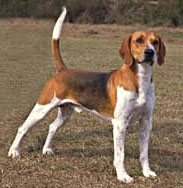|
The Canine Chronicles Directory
Harrier

The Harrier is a perfect small version of an English Foxhound. The Harrier has a
short, coarse coat. Their colors are usually tri-color (black/white/tan), red/white
or lemon/white although any color is allowed when showing the breed. The broad skull
is strong and the muzzle is square. The eyes are brown or hazel, the nose black
and the pendant ears rounded. The teeth should meet in a level or scissor-like bite.
The Harrier has large bones with a level topline. The front toes slightly turn inward
and the feet are cat-like in shape. The tail is carried high, but should not be
curled over the back.
|
|
Temperament
|
Harriers are cheerful, active, sweet-tempered and tolerant dogs. They are excellent
with children and good with other dogs. They should not be trusted with non-canine
pets unless raised with them from an early age. This breed needs plenty of exercise.
They love to explore, sniff and trail. Due to this, they should be kept on a leash
or in a well fenced in area. Some lines enjoy baying.
|
|
Height, Weight
|
Male Height: 19-21" ; Weight: 40-60 lbs.
|
|
Health Problems
|
This breed is very hardy but occasionally can be prone to hip dysplasia and epilepsy.
|
|
Living Conditions
|
It is not recommended to keep a Harrier in an apartment. They do best with lots
of acreage.
|
|
Exercise
|
This breed needs daily vigorous exercise. They can become a nuisance if they do
not get enough outdoor exercise. They make excellent jogging companions. Keep them
on a leash as they may take off after an interesting scent.
|
|
Life Expectancy
|
About 10-12 years
|
|
Grooming
|
This breed is easy to groom with brushing and occasionally shampoos. They are average
shedders.
|
|
Origin
|
The origin and development of the breed is somewhat of a mystery. Records have been
found specifically concerning English Harrier packs dating back to the 13th century.
Greek writings have also been found describing hare hunting breeds from as far back
as 400 years before Christ. Harrier actually means "hound" in Norman-Saxon and it
is speculated that they arrived during the Norman conquest of England. During the
17th and 18th century, Harriers were deemed the poor man's alternative to the upper
class' practice of pack hunting. This breed had an excellent nose and superior stamina
which allowed for swift hunting. They were used specifically to hunt hares. There
are several theories surrounding the actual creation of this breed. The first theory
states that the breed is a cross between the English Foxhound, the Fox Terrier,
and the Greyhound. The second theory states that the breed is a cross between Bloodhounds,
the Talbot Hound, and the Basset Hound. The third theory states that the breed is
a bred down version of the English Foxhound. The fourth and final theory is that
they are a cross between the Beagle and English Foxhound. Despite how it was created,
this breed has been used for centuries to hunt hare and other small animals. The
Harrier has been used in the United States since Colonial days; however, they are
still fairly rare. They are recognized by the AKC and the UKC.
|
|
Group
|
AKC Hound, UKC Scenthound
|